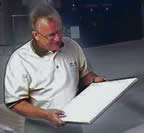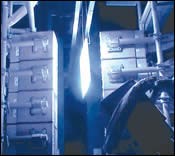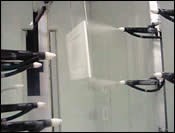Head of the Class
When Toronto-based RadEX Powder Coatings expanded its offerings to include wood finishing, the company selected UV powder coatings as the right tool for the job...
#curing
“It’s been a two-year school of hard knocks but we passed,” says Glen McLean, general manager of RadEX powder coatings. “The learning curve has been quite steep.”
McLean is referring to his company’s campaign into the world of UV powder coating on wood (specifically, medium density fiberboard [MDF] components), an endeavor that began in mid-1999, when Owner Ken Giles invested $3 million into a new 30,000-sq ft facility developed to complement his existing metal powder coating business, H&G Powder Coatings.
Featured Content
After making the decision to begin powder coating on wood, RadEX considered alternatives to UV like low-temperature thermosets, but they ultimately felt the low temperatures used with UV would be a benefit for wood and plastic products.
Undiscovered Country
As the first Canadian UV powder coater for wood—and only the second in North America—RadEX was, in some ways, venturing into unknown territory. Since being in the custom powder coating business requires becoming an expert on many different parts and powders, the company realized that it would need to do considerable research in a relatively short amount of time. “One day you quote a job and prepare a few samples. Next, you’re coating thousands of parts,” says McLean.
“We met with everyone knowledgeable in the business,” says RadEX Technical Director Rick Grimm. “We traveled to Europe and spent a lot of time learning from industry suppliers.”
RadEX sought out suppliers that could also function as guides in its quest to understand and master the new technology. One such candidate was powder coating equipment supplier Nordson Corporation, Industrial Coating Systems. “We selected Nordson because we were quite impressed with what they demonstrated in their laboratory. Not only were they an equipment supplier, but a knowledgeable partner that could help with the process.”
“UV powder coating equipment is straightforward enough,” acknowledges Steve Brattoli, Nordson heat-sensitive substrates laboratory expert. “Even though it’s the same equipment you might use for other powder coating applications, the ‘art’ is in the setup, preparation and process control.” It is in those areas that RadEX was able to rely on Nordson’s experience.
The RadEX system uses a Nordson ColorMaxTM quick-color-change booth and the latest Sure CoatTM spray gun technology. “It’s a custom-coating environment,” observes Grimm, “so we need to spray many different powders without a lot of hassle when changing colors.
“We run a lot of smaller-sized batches with a lot of different powders, so the Nordson cyclone system is ideal for us. It takes half the time to change powder here than it does on our metal coating line that has older reclaim technology.”
“We also need contamination-free powder changes since we’re making samples that could determine whether a customer decides to move forward or not — we can’t afford not to put the absolute best foot forward with a new technology.”
To help take more control of the process, Giles added some additional upstream processing capabilities. “We acquired sanding and CNC routing equipment so we could help customers take their product from design to a finished product. It helps us control final quality by ensuring that surface preparation and handling of the board are all controlled and within specification. Now we have the ability to make any style MDF part you’d like—you give me the CAD drawings, we’ll give you the part.”
The Road Ahead
Although the market has been softened by a weak economy there have been some good success stories along the way. “We are making all sorts of powder-coated wood parts for people who want to get into the technology but don’t want to make the huge capital investment yet,” McLean says. “We’ve made tabletops for contract furniture makers, keyboard trays and tables used for medical applications and car dealerships.”
The wide range of commercial applications has also allowed RadEX to build a large database of knowledge. “We’ve run boards from nearly every wood manufacturer and kept careful track of how to preheat the board, apply powder and cure it,” says Grimm. “There are a thousand different things and like anything, the last 20% of the solution is the hardest to find and perfect.”
RadEX is optimistic about filling up its line with its 14 million board feet per year of capacity. “We’ve seen steadily increasing interest in powder coating wood since we started,” says McLean. “Partially because word continues to spread as commercial successes are achieved and partially because improvements in powder’s performance and cosmetics are getting better.”
Powder suppliers like David Ades, managing director of Montreal-based Protech Chemicals Ltd., agrees. “We made more progress last year than we did in the previous five. Now we have products that fall well within the market’s expectations for price, performance and appearance.” As Canadian neighbors, Protech and RadEX have teamed up on various projects so far.
What about others jumping on the UV bandwagon? “We’re glad to see others get involved even if it means less business for us,” says McLean. “We need success stories—and more good applications mean more credibility for this new technology.”
“For instance, when Knoll Manufacturing, one of the most respected office furniture companies added UV to their thermoset powder line, we were really thrilled.”
McLean ventures even further. “In fact, we’ll tell a potential customer ‘let us coat your product for one year while you learn the ropes, and then we’ll help you put in your own installation.'”
McLean feels that UV powder coatings are becoming more and more attractive. “UV powder costs have come down over the last couple years as more volume of this new product has been produced. As you can imagine, the first few pounds of powder were pretty expensive. This, combined with rising labor rates for the operations required for liquid painting and laminating have tipped the scales in our favor.”
“A couple of years ago, we were looking in the mirror and asking ourselves if we did the right thing by making this investment so early,” says McLean, “but those fears have gone away. The line is paying for itself and we see a lot of the people we did trials for over the past couple of years coming back to us now with real projects.”
As for the company’s proficiency with UV powder coatings, that too has come a long way. “Now we’re quite good at it,” says Grimm. “For a year and a half, it’s all we’ve done—concentrate on how this powder behaves on that board. I’d say now we’re as good or better than any UV powder coater in the world.”
RELATED CONTENT
-
The Powder Coating Process
Powder coating is one of the most durable finishes that can be applied to industrial manufactured products, and offers excellent corrosion protection and is very safe because of its lack of volatile organic compounds. To understand the powder coating process you should start with the fundamentals.
-
Masking for Surface Finishing
Masking is employed in most any metal finishing operation where only a specifically defined area of the surface of a part must be exposed to a process. Conversely, masking may be employed on a surface where treatment is either not required or must be avoided. This article covers the many aspects of masking for metal finishing, including applications, methods and the various types of masking employed.
-
Calculating the Cost of Powder Coating
How can you calculate the cost of powder coating a component if you only know its surface area? Powder coating expert Rodger Talbert has the answer.





















